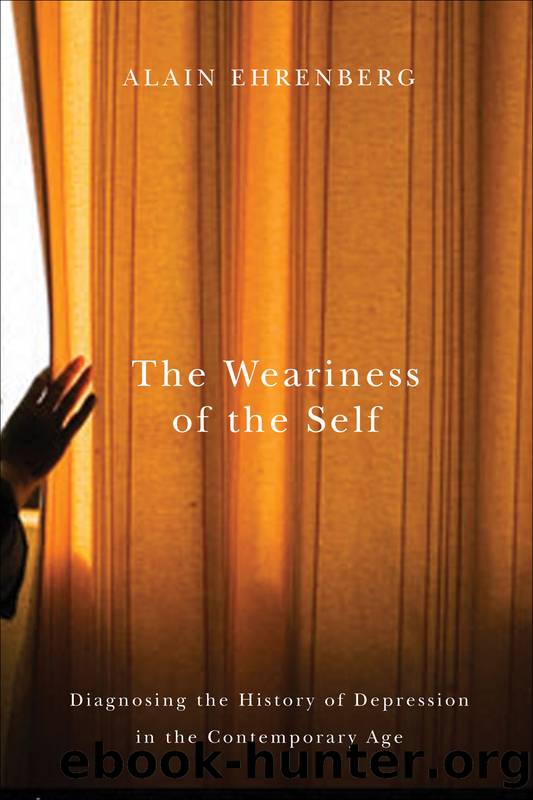Weariness of the Self by Ehrenberg Alain;

Author:Ehrenberg, Alain; [Ehrenberg, Alain]
Language: eng
Format: epub
Publisher: McGill-Queen's University Press
Published: 2010-02-14T16:00:00+00:00
PART THREE
THE INADEQUATE INDIVIDUAL
The physiology of automatism is easier to describe than that of autonomy.
Georges Canguilhem, La formation du concept de réflexe
auxxviie etxviiie siècles,1955 (7)
Depression is not a subjective state, it is a style of action.
Daniel Widlöcher, âLâéchelle de ralentissement dépressif:
Fondements théoriques et premiers résultats,â 1981 (56)
PATHOLOGICAL ACTION: THE SECOND SHIFT IN THE REPRESENTATION OF THE INDIVIDUAL
The first shift in direction for the system of norms defining the individual in the first half of the twentieth century involved âbeing oneself.â This is what characterized the âgeneral spiritâ of the new normality. At the pathological level, clinical practice, especially that of psychoanalysis, altered its focus from a domain where conflict, guilt, and anxiety prevailed to a domain where inadequacy, the void, compulsion, and impulse delineated the portrait of pathological humanity. The new normative approach and the new pathology were concerned less with identification (with well-defined parental images or social roles) than with identity. Identity was the first instrument leading to the redefinition of todayâs individual. During the 1980s, self-affirmation worked its way into everyday life to the point where a housewife under the age of fifty did not hesitate to bare the most intimate details of her private life on television.
This decade was innovative in another way. It was not simply a matter of being oneself, of setting out blissfully in search of oneâs âauthenticityâ; one also had to act on oneâs own, to rely on oneâs own internal resources.1 The second instrument of turn-of-the-century individuality was that of individual action.
The gospel of personal fulfilment was backed up by the commandments of individual initiative. The questions of identity and of action came together in the following way: on the normative side, individual initiative joined forces with psychic liberation; on the pathological side, a difficulty in initiating action was associated with identity insecurity. The eclipse of regulation through discipline led to the individual agentâs being responsible for his own actions. At the same time, psychiatric thinking was more and more convinced that the fundamental problem in depression was psychomotor: what had been a mood disorder was now a dysfunction in mental activity. To violate the norm was less a matter of disobedience than of being unable to act. This was a new concept of individuality.
Chapter 6 puts forward the hypothesis that depression would from now on be characterized by two main attributes, one of which is entangled with the other. First, the very idea of a depressive syndrome collapsed. Second, the psychiatric gaze shifted to the pathological act: inhibition and âpsychomotor slowingâ took precedence over mental pain and sadness. At the same time, the pharmaceutical industry launched a new generation of molecules unprecedented in their promises of a cure. This shift in the psychiatric approach to depression was related to the context in which it occurred: a demand for action that weighed increasingly on each individual. There was a demand for medicinal assistance. Psychiatric literature spread the news, the media became concerned, public authorities set up commissions or commissioned reports that had no impact on public behaviour.
Download
This site does not store any files on its server. We only index and link to content provided by other sites. Please contact the content providers to delete copyright contents if any and email us, we'll remove relevant links or contents immediately.
The Concise Laws of Human Nature by Robert Greene(1725)
Bioenergetica by Alexander Lowen(1373)
After by Bruce Greyson(1179)
The Child in You by Stefanie Stahl(1156)
No Bad Parts by Richard C. Schwartz(1095)
Stress-Proof Your Brain The Yogic Way: Unique Ancient Indian Techniques to End Toxic Stress, Stop Worrying and Inculcate Mental Toughness by Advait(1062)
Badass Habits: Cultivate the Awareness, Boundaries, and Daily Upgrades You Need to Make Them Stick by Jen Sincero(978)
Talk of the Ton by unknow(966)
The Power of Myth by Joseph Campbell & Bill Moyers(930)
Chakras & Self-Care by Ambi Kavanagh(890)
Self-Care for Empaths by Tanya Carroll Richardson(845)
Learn To Think Using Thought Experiments by King Patrick(830)
The Mind by E. Bruce Goldstein(822)
Curative Magic by Rachel Patterson(798)
The 7 Secrets of Sound Healing Revised Edition by Jonathan Goldman(786)
The Tao of Intimacy and Ecstasy by Solala Towler(779)
The Anxiety First Aid Kit by Rick Hanson(763)
The Quantum Psychiatrist: From Zero to Zen Using Evidence-Based Solutions Beyond Medication and Therapy by Biswas Dona(742)
Living a Life of Awareness by Don Miguel Ruiz Jr(740)
